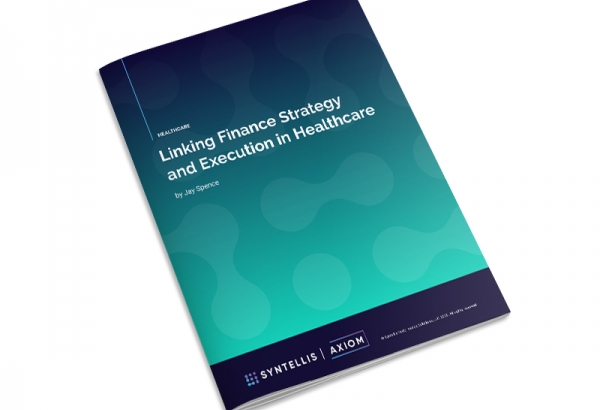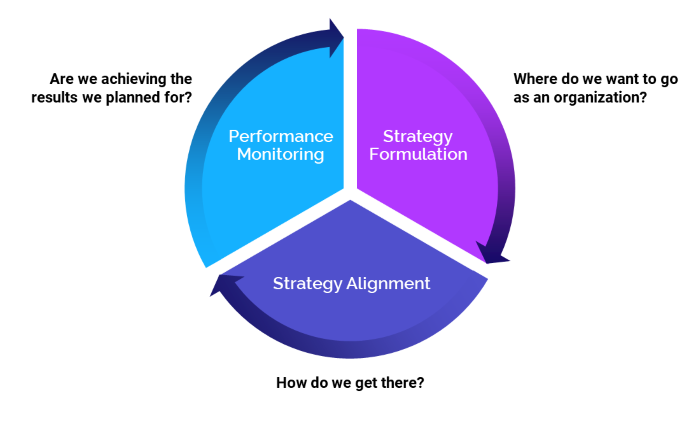The Basics of continuous planning
What is continuous planning?
Continuous planning is an organizational leadership and management approach that integrates strategic and financial planning efforts across all facets of an organization to foster informed, timely, and data-driven decision-making. It encompasses long-range strategic financial planning and the broad set of enterprise performance management functions — including multi-year financial forecasting, capital planning, operational budgeting, financial reporting, managerial reporting, cost accounting, and rolling forecasting.
Rather than each of these being its own siloed process, as with more traditional approaches, continuous planning marries them all in an integrated, interdependent, cyclical flow. Continuous planning enables organizational leaders to continuously monitor the status of strategic initiatives, operations, and budget projections against actual organizational performance. Armed with these insights, leaders are better equipped to manage the entity’s resources, establish more accurate projections of future performance, and plan accordingly.
What is the purpose of continuous planning?
From the pressures of ever-evolving competition to ongoing economic uncertainties, organizations across nearly every industry are caught in a very dynamic environment. They must be agile, and prepared to recalibrate or change course in the event of sudden market shifts.
Chief Finance Officers and other finance executives face increasing pressures to play a more active role in determining an organization’s strategic direction. Organizations frequently depend on these individuals to provide greater visibility into how financials affect overall business strategy, and to translate the impacts of defined strategies on operational and tactical plans.
Continuous planning establishes a finance business continuity plan that provides the frameworks and tools to align organizations around three critical areas: strategy formulation, strategy alignment, and performance monitoring.
What are the advantages of continuous planning?
Continuous planning provides executive leaders with a more accurate, comprehensive, and timely view of organizational performance relative to available resources, operational needs, and strategic goals. This empowers them to leverage financial and operational data to be more nimble and responsive in their decision-making.
During these times of significant and ongoing change, continuous planning enables organizations to more quickly and easily adjust strategies and plans if business circumstances suddenly shift. A continuous planning approach also facilitates a faster budget planning cycle, more transparency, and greater collaboration among finance and other departments or units across an organization.
What are the challenges to implementing continuous planning?
Common barriers to continuous planning include a lack of adequate resources, outdated methods and attitudes toward the role of finance, and organizational cultures that are resistant to change.
Continuous planning requires executive leaders to completely re-think their approach to strategic and financial planning. This can be especially challenging for those who rely on stand-alone spreadsheets or rigid planning applications that involve time-consuming, manual processes.
To shift to more integrated, continuous planning, finance leaders must embrace the latest technological advancements with integrated enterprise performance management tools. Such tools engage stakeholders across the organization, streamline processes, reduce duplication of efforts, and make it easier to conduct scenario modeling or other financial modeling exercises.
establishing a finance business continuity plan
Step 1: Continuous planning strategy formulation
Strategy formulation is an initial step in linking strategy and execution as part of continuous planning. The tools and activities used to support strategy formulation should answer the questions:
- Where are we going as an organization?
- What initiatives are needed to get there?
Perform dynamic ‘what-if’ modeling and scenario analysis
Financial forecasting is an important component of continuous planning and the strategy development process. Given the high levels of uncertainty in today’s environment, more demands are being placed on finance professionals to perform dynamic “what-if” modeling and show alternative future views. This includes layering the financial impacts of including (or excluding) strategic initiatives, such as launching new services or expanding facilities.
When attempting to forecast and model varying scenarios, finance professionals should start with a base case given current trends and future expectations, and then layer on the impact of discretely modeled initiatives. While challenging to do using stand-alone spreadsheets, modern software solutions can simply and quickly perform scenario modeling and forecasting of varying versions of growth and cost management initiatives. This approach allows for detailed and accurate modeling of each initiative to ensure that the go-forward impacts are well understood.
Scenario analyses provide a competitive advantage by evaluating various combinations of activities. This allows finance leaders to identify the best mix of initiatives to support business and financial goals, prepare for potential changes, and respond more nimbly when changes occur.
Allocate capital to align with strategic goals
Capital planning has become an increasingly strategic function for many organizations. If done effectively, allocating capital dollars to projects — such as construction, equipment purchases, and information technology (IT) needs — can positively impact an organization’s competitive positioning and help facilitate growth. The challenge for many finance leaders is the lack of enabling tools and frameworks to streamline initiating, evaluating, approving, and monitoring capital projects that best align and support the organization’s overall strategic plan.
What makes this such a challenging process? For many organizations, the award process often is not based on merit, but rather on a “first come, first serve” basis, frustrating those making requests and skewing organizational priorities. Transforming the process should address the following areas:
- Initiating new requests: By standardizing the input form(s) associated with all new capital requests, you can structure how proposed projects will be evaluated across financial and non-financial measures. Initiators should be guided with prompts or comments fields to define the core elements of the project in a consistent manner. Examples include Project Owner and Sponsor, Spend Category (i.e., Construction, IT), Justification, Capital Needs (current and future years), and Strategic Goal Alignment.
- Reviewing submissions: Especially for larger capital requests, conditional workflow tools should be used to automate alerts and notifications to key contributors when their input is needed. For example, large technology projects may need to go to IT and Legal for evaluation before finalizing. These expert reviews ensure that each project is complete and accurate.
- Evaluating and approving projects: By having access to a single source of consistently defined project submissions and effective reporting tools, the evaluation committee(s) can effectively review and compare requests. Ideally, approved projects will create a portfolio of investments that span construction, IT, and equipment investment.
- Tracking progress: Having timely access to reports that highlight actual project spend to-date against approved capital gives executive leaders visibility to monitor progress and assure committed funds are tracking as expected. Ideally, progress monitoring is supported by transaction-level financial reporting and includes project-related commentary to highlight milestone achievements.
Step 2: Continuous planning strategy alignment
As previously mentioned, finance plays a critical role in helping to translate the impact of defined strategies on operational and tactical plans. These continuous planning activities help ensure alignment between financial and strategic planning efforts by guiding organizational leaders to answer the question: How do we get there? Two common areas of focus in strategy alignment are statistical planning approaches and initiative-based planning.
Incorporate statistically driven planning approaches
For many organizations, the use of stand-alone spreadsheets or rigid planning applications has relegated the planning function to more of a bottoms-up, data-collection activity. In turn, the ability to adjust the plans and account for strategic initiatives (i.e., additional capacity) or baseline projections related to revenue and expense plans becomes a time-consuming, manual process.
By contrast, statistically driven planning models leverage existing relationships, such as the relationship between revenue drivers and departmental plans. As a result, changes made globally easily flow through to net revenue plans, workload, and labor and expense plans.
Leverage initiatives-based planning
Initiative planning provides the ability to translate high-level strategy into actionable operational plans. Dynamic planning models increasingly incorporate the initiative as a planning dimension. This allows the cross-departmental initiative to be modeled discretely and in detail, then layered as an incremental expense into the baseline budget model. The benefit is two-fold:
- Managers can clearly identify the impacts each initiative is having on final budget targets
- Initiatives can be changed efficiently if underlying assumptions prove invalid
Step 3: Continuous planning performance monitoring
To effectively manage defined strategies and financial plans for continuous planning, they must be monitored on an ongoing basis. To determine their success, finance professionals must answer the following questions:
- Are we achieving the results we hoped?
- Do we have visibility into where outliers exist and why?
Finance teams leverage several techniques — rolling forecasts, executive reporting, and alerts/notifications — to better understand their success in executing their defined strategies.
Build flexibility with rolling forecasts
Finance teams are embracing — and benefiting from — rolling forecasts as a way to monitor and trend performance against established financial targets. Actual and monthly projections out 18 months provide a trended view of performance, typically represented at an entity level. These models help assess current realities and can influence longer-range (multi-year) projections and detailed operational plans. These tools help finance professionals more effectively monitor where established planning assumptions may be inaccurate. This enables them to more proactively address corrective action plans or reforecast where needed.
Provide clarity with role-based scorecards, dashboards, and mobility
Finance teams are stewards of data that guide business decisions — such as cost and profitability analytics and target staffing calculations. The notion of information delivered by role is important to ensure that end users aren’t overloaded with information; rather, they are directed with the right information, at an appropriate level of detail, to decision-making. Tools that can visualize data and allow for mobility (i.e., delivery via a tablet or mobile phone) are an important complement to traditional management reporting.
Enhance communication with alerts, notifications, and comments collection tools
The ultimate goal of any performance monitoring function is to establish clear visibility of outliers to plans and scenarios across management levels. All too often, however, reporting becomes a one-directional dump of financial and operational statistics that poorly highlight “what” is wrong but offers no feedback loop to more senior leaders as to “why.” Best practice approaches leverage alerts to highlight where variances exist, incorporate push notifications (i.e., via email) to stakeholders, and provide a vehicle to collect comments and action plans on high-threshold outliers. This creates a more robust, closed-loop reporting cycle across management levels within the organization.
With visual, actionable reporting and scorecards that utilize these three components, finance leaders can comprehensively view organizational performance. Leaders then can quickly identify areas where initiatives are underperforming, drill down to specific KPIs, and compare actual performance against targets. They can then use these insights to recalibrate as needed and focus an organization’s resources on areas where they will have the most significant strategic impact.
Continuous planning for modern finance teams
For effective strategy execution, organizations must move away from stagnant, siloed annual budgeting and one-dimensional financial forecasting exercises. Continuous planning essentially creates an ongoing budget process, representing an evolution to a more integrated financial, operational, and strategic planning approach that touches the entire organization. It provides the frameworks and tools for effective strategy formulation, strategy alignment, and performance monitoring.
During these times of significant and ongoing change, continuous planning also enables organizations to more quickly and easily adjust those strategies and plans if business circumstances suddenly shift. In addition, a continuous planning approach facilitates a faster budgeting planning cycle, more transparency, and greater collaboration among finance and other departments or units across an organization.




See why finance leaders trust Axiom software for their continuous planning process
LEARN THE BEST PRACTICES FOR CONTINUOUS PLANNING IN YOUR INDUSTRY

Linking Finance Strategy and Execution in Healthcare

How a Transformed Budget Process Positioned WVU for Agility


